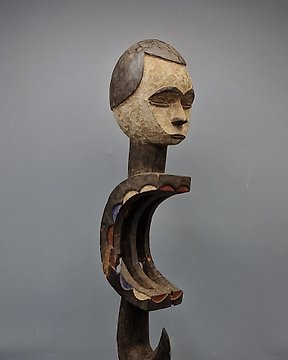
Rzadki i imponujący herb EKPO - EKET - Nigeria (Bez ceny minimalnej )
Nr 83434437

Nr 83434437

A Queen mother bronze head, called Uhunmwu elao ọghe Iy’ọba,in the style of Benin.
There are three things that are special about this Queen Mother figure.
1. the almost vertical hood, which gives it royal dignity. Other depictions of this type of figure range from a curved beaded hood to a hood that resembles a relatively short pointed cap.
2. The surface of this bronze. We can assume that in the 1960s and 1970s most Benin bronzes were "cleaned" in museums and private collections. A "restoration" that consisted of getting as close as possible to an assumed original state and stopping corrosion of the metal. Today, old bronzes are treated much more sensitively because the surface patina can also provide important information about the context of the find, to briefly touch on this topic. But what is crucial about this bronze is its "unrestored condition", which, when viewed through a linescan, an electron microscope or even under multiple optical magnifications such as Photoshop, reveals a complex structure of the bronze's oxidation, which can be important for assigning its age. (see magnification at the end of this photosequence)
3. And this brings me to the strangest feature of this Queen Mother Bronze. Scarification scars on both sides of the forehead are common and vary between three and four vertical elevations. The iron inlays, which were lost in this bronze but still show clear traces of oxidized iron traces, are also not unusual. What is unique, however, is the hanging, cone-shaped protuberance, which appears to be crowned with a "pearl" at the tip. It is located in the middle of the two former iron inlays. We only know something similar from the male Uhunmwu-Elao bronze heads or the Ewua priest figures, but from none of the Queen Mother figures depicted in DB. We are sure that there are other examples outside the museum world with this special feature.
wj.
Uhunmwu-Elao bronze head, Luschan, Die Altertümer Benins , Plate 53 (last photo sequence).
This ancestor head was cast in memory of a deceased queen mother. She can be recognized by the typical conical braid hairstyle covered by a beaded cap. On the forehead there are raised decorative scars, as well as a large pearl, which refers to the proverb: "You can never touch the forehead of a leopard". After 1550, these ancestor heads show less and less individual facial features, but are more to be understood as an idealized portrait with status symbols and insignia of rulership. The mother of the reigning king represented an important counterweight to his power. She resided in her own palace, administered her own province, spoke up for petitioners, and could also grant political asylum. Text: Dietmar Neitzke.
This type of commemorative queen mother head is normally placed at an altar to honor her, the ly’Oba. These cast iron heads are distinguished by their tall, cone hairstyle. Indicating a higher status, the head has four suborbital markings, which are usually reserved for men, instead of the usual three for women. It is thought that Oba Esigie (c. 1516 to 1550) introduced the title of ly’Oba to honor his mother, Queen Idia. The tradition of casting bronze heads of kings and queens for altars is considered to be the oldest kind of palace art in Benin and done by professional artisans. The depictions are not realistic but more as symbolic or metaphorical. The Queen Mother often sports a mesh hairdo, created by the “lost wax technique.“ First, the earthen block is covered with wax and shaped. Then, clay is put on top of it and heated. The wax leaks out and a metal alloy then poured in. Certificate of authencity and provenance.
F. Luschan, „Die Altertümer von Benin“, Veröffentlichungen aus dem Museum für Völkerkunde, Bd. ... de Gruyter, Berlin & Leipzig, 1919., Schlothauer, Andreas. 2012. Gefunden - Drei Beninköpfe ehemals Berlin. In: Kunst&Kontext 1/2012: 77-80., U. Beisiegel, M. Reich, K. Pietzner, und V. Viebahn, „The collections, museums and gardens of Göttingen University“. Univ.-Verl. Göttingen, Göttingen, 2015,. Verfügbar unter:p. 26, 34.), „Benin, Könige und Rituale : höfische Kunst aus Nigeria ; eine Ausstellung des Museums für Völkerkunde Wien - Kunsthistorisches Museum .. ; Ausstellungsorte Museum für Wölkerkunde Wien, 9. Mai - 3. September 2007, Museé du Quai Branly, Paris, 2. Oktober 2007 - 6. Januar 2008; Ethnologisches Museum, Staatliche Museen zu Berlin, 7. Februar - 25. Mai 2008 ..“. Snoeck [u.a.], Antwerpen, 2007., „Kunst aus Benin - Sammlung Hans Meyer. Patrimonia ; 220“. Kulturstiftung der Länder [u.a.], Berlin, 2002. (S.23-25; 82).
Jak kupować w serwisie Catawiki
1. Odkryj coś wyjątkowego
2. Złóż najwyższą ofertę
3. Dokonaj bezpiecznej płatności